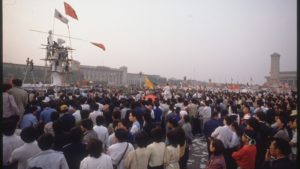American analysts keep trying to fit the country into familiar patterns—ignoring the many ways in which it’s an exception.

On my campus back then were just a handful of students majoring in East Asian studies. Learning of the brutal crackdown in Beijing, we somehow found one another, gathered our friends, and stayed up making hundreds of white armbands for classmates to wear at commencement the next day. Grappling with the cold realities of the “real world” we were about to enter, we didn’t know what else to do. So we tore sheets and cried for what might have been.
The June 4, 1989, massacre was a horrifying spectacle that the Chinese government has sought to erase from national memory ever since. But, 30 years later, contemplating what might have been is more important than ever. In hindsight, Tiananmen Square serves as a continuing reminder about just how much China has defied, and continues to defy, the odds and predictions of experts. The fact is that generations of American policy makers, political scientists, and economists have gotten China wrong more often than they’ve gotten China right. In domestic politics, economic development, and foreign policy, China has charted a surprising path that flies in the face of professional prognostications, general theories about anything, and the experience of other nations.
In the 1950s and ’60s, American policy toward China suffered because of the “monolithic communism” view that had captured U.S. foreign-policy circles. Although we now know that China and the Soviet Union had very different communist models and national interests—and that their relationship was exceptionally troubled—successive administrations in the United States put China and the Soviet Union into the same enemy camp. Not until the Nixon administration did the United States began normalizing relations with China in what would be one of the greatest diplomatic triumphs in American history. Had American leaders recognized and capitalized upon the Sino-Soviet split earlier, one wonders how history might have unfolded differently.
Economic assessments weren’t any better. If you were an economist in the early years after World War II, the Nobel laureate Michael Spence has pointed out, you would have predicted that African nations were more likely to develop faster than China because they had greater natural-resource wealth. And you would have been dead wrong. In 1960, the average GDP per capita in the Democratic Republic of Congo was $220, about twice the per capita GDP in both Nigeria and China. By 2017, China’s GDP per capita had skyrocketed to nearly $9,000—more than four times that of Nigeria and 19 times greater than Congo’s. Since the Chinese government embarked on its modernization program, in 1978, Beijing has lifted more than 850 million people out of poverty and sustained the fastest economic growth in human history.
China’s domestic political system has also defied predictions. Many declared that China would eventually go the way of the other “Asian tigers”—Japan, Taiwan, and South Korea—which became more democratic as they grew rich. That never happened. And when the democratic wave swept across the communist world from 1989 to 1991, ending the Cold War and leading some to declare that the “end of history” had arrived, it skipped China. With dizzying speed, the Berlin Wall fell, East and West Germany were reunified, the Soviet Union collapsed, the Iron Curtain tumbled, and all the former communist regimes of Eastern Europe were replaced by democratically elected governments. The communist old guard was ousted just about everywhere except Beijing. When China’s moment of reckoning came, Communist Party leaders chose bullets, not ballots. And they made a long-shot, long-term Faustian deal to guarantee economic development in exchange for continued party control that has lasted ever since.
Why have so many been so off about China for so long? In part it’s because policy makers and academics alike look for patterns, not exceptions. We are trained to generalize across cases and use history as a guide to the future. But China has always been sui generis—an innovator in the ancient world that became a poverty-stricken nation in the modern one; a nation with a deep and proud imperial history ruled by a post-1949 Communist leadership with an aversion to remembering it; a rural nation with some of the world’s most sophisticated high-tech surveillance.
There is also a fundamental disconnect in how American and Chinese leaders see time. For Americans, memories are short, attention is fleeting, and policy lurches from crisis to crisis. In Washington, passing a budget and keeping the lights on seem more and more like heroic acts. In China, by contrast, memories are long, attention is enduring, and the government plans for the long haul. China’s rise in artificial intelligence and other technologies has been in the works for years. Its military modernization started in the 1990s. Back then, a Chinese admiral was asked how long before China would build its own aircraft carrier. He replied, “in the near future”—by which he meant sometime before 2050.
These different views of time hang over modern geopolitics. For American leaders, U.S. global leadership is the way of things. For Chinese leaders, it is an aberration: China was a great power until the Opium Wars in the 1840s ushered in a “century of humiliation” by the West. In Beijing, China’s rise isn’t new. It’s a reversion to the way things used to be.
Donald Trump’s administration has turned the page, acknowledging that the United States and China are locked in a competitive struggle with some mutual interests and many conflicting ones. The administration’s fundamental China shift doesn’t get the attention or praise it deserves. Even so, getting U.S. policy on China right won’t be easy. Our economies are tightly interconnected, our domestic politics are each highly charged, and our security interests are more and more at odds. A good China policy starts by recognizing that China’s rise is in many ways unique, and that general patterns and predictions may obscure more than they clarify.
We want to hear what you think about this article. Submit a letter to the editor or write to [email protected].





